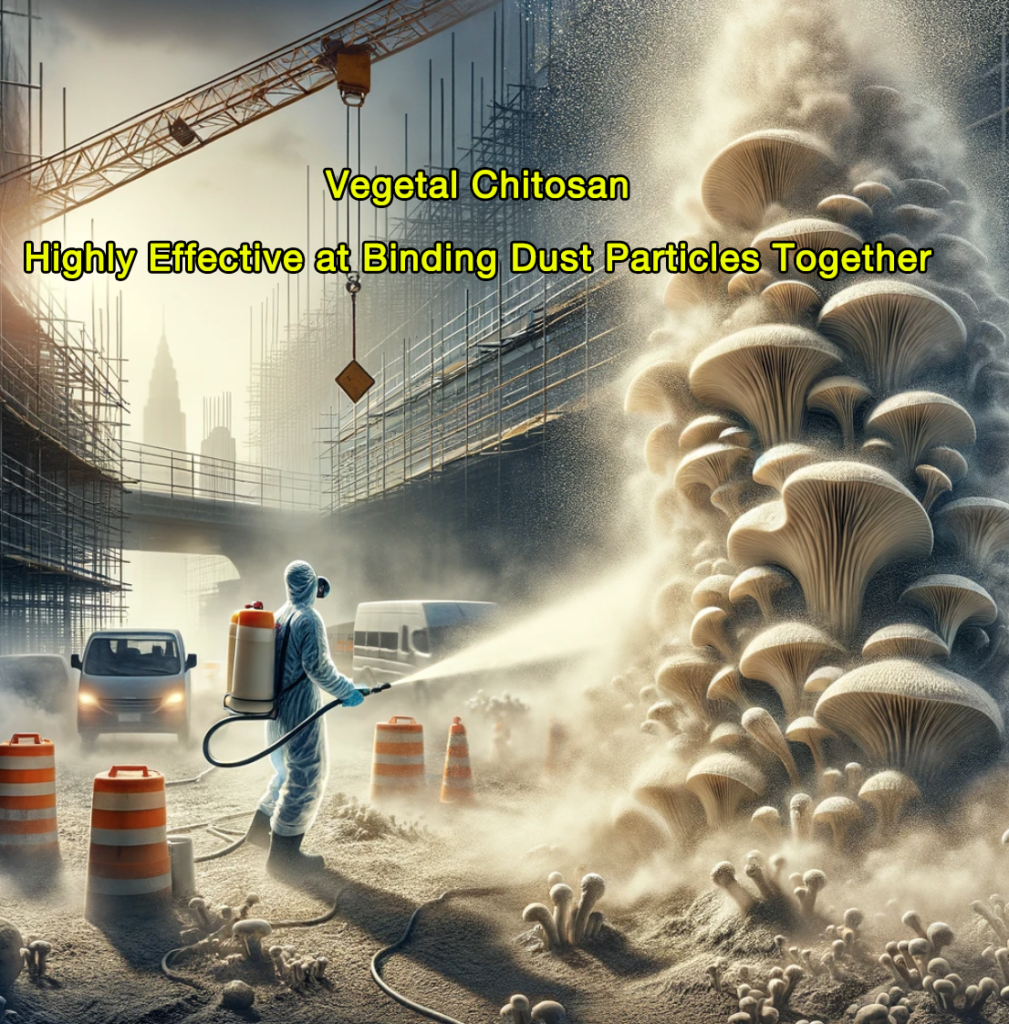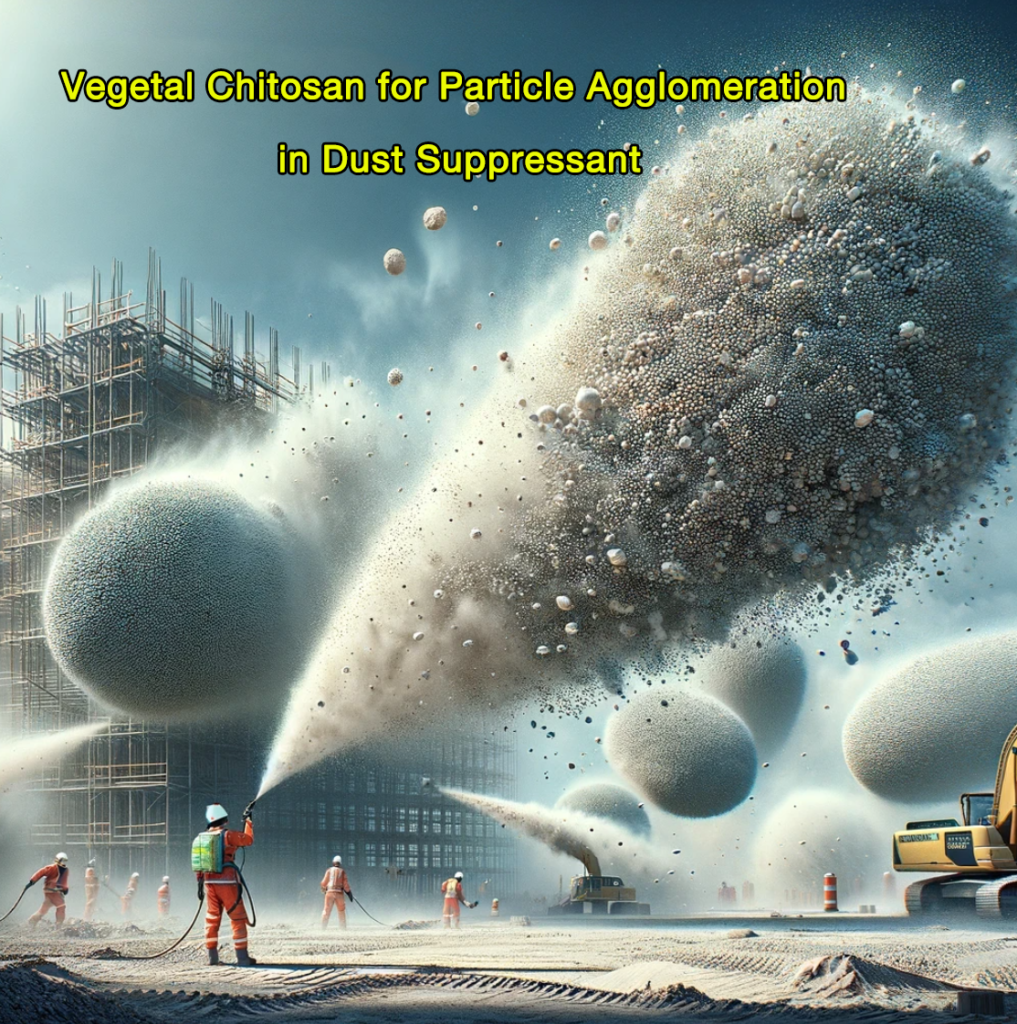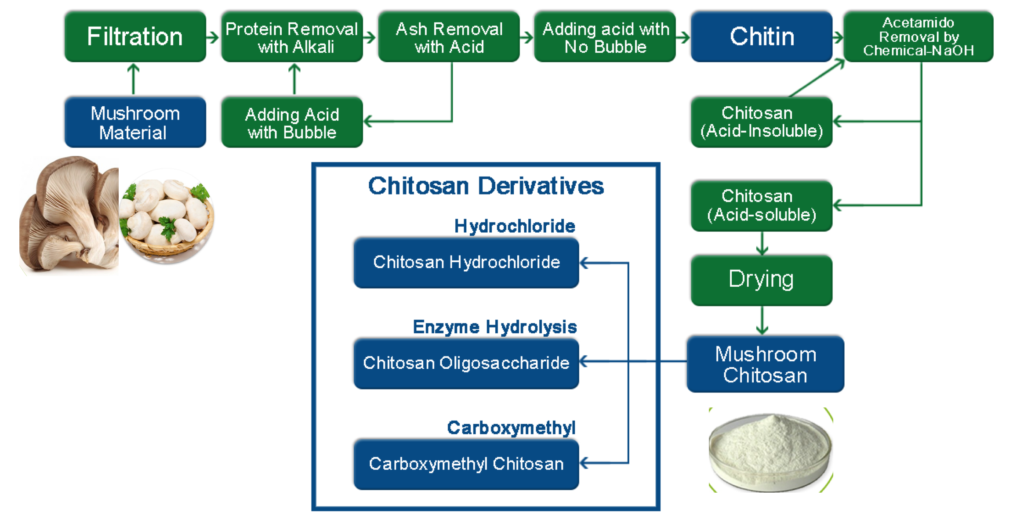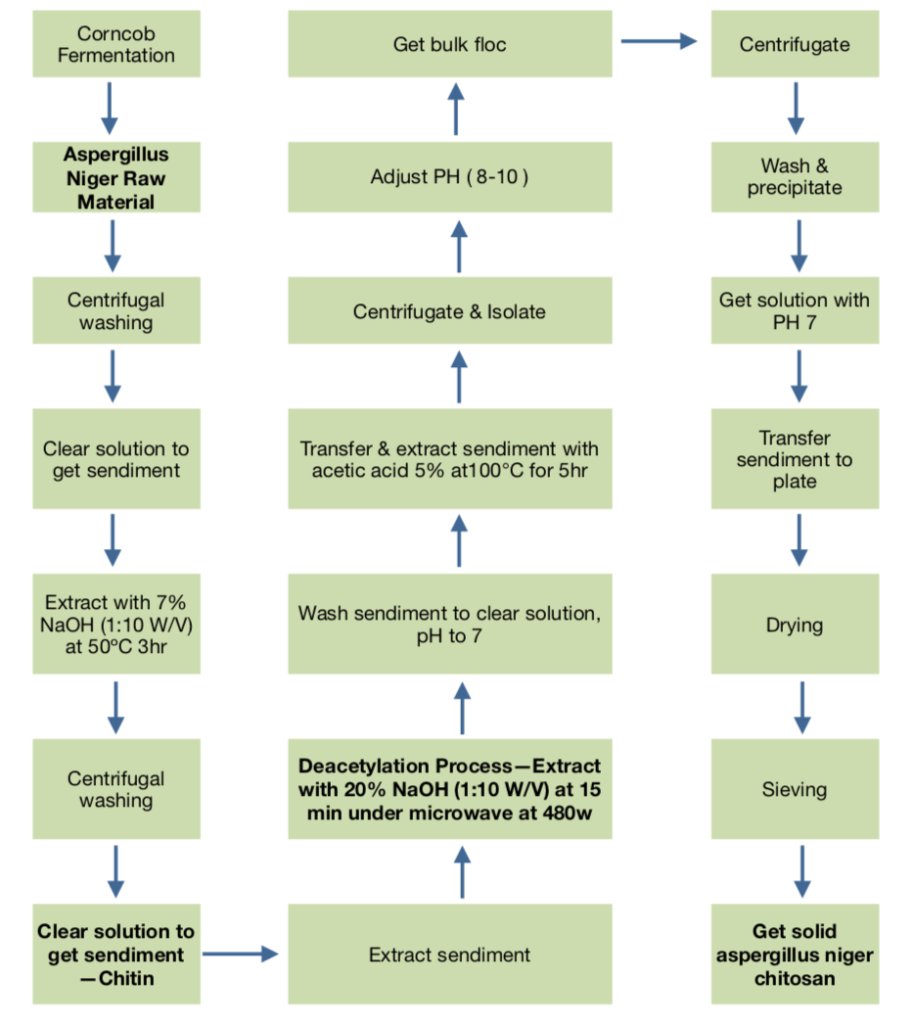1. What is vegetal chitosan?
Chitosan is a natural biopolymer that is primarily derived from chitin, which is the second most abundant natural polysaccharide after cellulose. Chitin is commonly found in the exoskeletons of crustaceans like crabs, shrimps, and lobsters, as well as in the cell walls of certain fungi like mushroom, aspergillus niger.
Structure and Properties:
- Chemical Structure: Chitosan is obtained by deacetylating chitin. This process involves removing acetyl groups from chitin, resulting in a polymer that has free amine groups.
- Solubility: Unlike chitin, chitosan is soluble in acidic to neutral solutions, making it more versatile for various applications.
- Biocompatibility and Biodegradability: Chitosan is known for its excellent biocompatibility and biodegradability. It’s non-toxic and can be broken down by natural biological processes.

Chitosan, sometimes known as deacetylated chitin, is a natural polycationic linear polysaccharide derived from partial deacetylation of chitin. Chitin is the structural element in the exoskeleton of insects, crustaceans (mainly shrimps and crabs shell), and cell walls of fungi (oyster mushroom, agaricus bisprous and aspergillus niger), and also is the second most abundant natural polysaccharide after cellulose.

Chitosan, a natural polysaccharide prepared of fungal origin, is initially extracted and purified from reliable and abundant food or biotechnological fungal sources such as Agaricus bisporus or Aspergillus niger.
Chitosan is composed of glucosamine sugar units (deacetylated units) and N-acetyl-D-glucosamine units (acetylated units) interconnected by ß→(1.4) type linkages.
Uses and Applications:
- Medical and Pharmaceutical Fields: Due to its biocompatibility and non-toxic nature, chitosan is used in wound healing, drug delivery systems, and as a biomaterial in tissue engineering.
- Water Treatment: Its ability to bind with heavy metals and other contaminants makes it useful in water purification and treatment processes.
- Agriculture: As a natural biostimulant and elicitor, chitosan is used to enhance plant growth and provide resistance against pathogens.
- Food Industry: It’s used as a food additive for its antimicrobial properties, and as an edible film or coating to enhance the shelf life of perishable food products.
- Cosmetics and Personal Care: In this realm, it finds use as a thickener, moisturizer, and film-forming agent, particularly in hair and skin care products.

Chitosan has been widely used in various fields, including wine, pharmaceuticals, dietary supplement, medicine, agriculture, and food industries, due to its biocompatibility, biodegradability, and non-toxicity. In recent years, researchers have investigated the use of vegetal chitosan, which is derived from fungal or plant sources, as a sustainable alternative for use in wine applications.
Variants:
- Traditional Chitosan: Traditionally sourced from marine crustaceans.
- Vegetal Chitosan: Derived from fungal sources, offering an alternative for those seeking non-animal derived products.
In summary, chitosan’s versatility, biodegradability, and non-toxic nature make it a valuable material across various industries, from healthcare to cosmetics. Its ability to be derived from non-animal sources also makes it an appealing option for vegetarian and vegan-friendly products.
2. What are the advantages of vegetal chitosan?
Vegetal chitosan, also known as fungal chitosan or mycelium chitosan, is a type of chitosan derived from the cell walls of fungi (mushroom and aspergillu niger). It has several advantages over traditional chitosan derived from shellfish, including:

- 1. Vegan and vegetarian-friendly: Vegetal chitosan is an excellent alternative for individuals who avoid animal-based products, such as those who follow a vegan or vegetarian lifestyle.
- 2. Allergen-free: Traditional chitosan is derived from shellfish, which can cause allergic reactions in some people. Vegetal chitosan does not contain any shellfish-derived ingredients, making it an allergen-free option.
- 3. Purer: Vegetal chitosan is often considered to be purer than traditional chitosan because it is derived from a single source, whereas traditional chitosan can be contaminated with other shellfish-related substances.
- 4. Better solubility: Vegetal chitosan is more soluble than traditional chitosan, which makes it easier to incorporate into various applications such as cosmetics, pharmaceuticals, wine and food.
- 5. Improved bioavailability: Some studies have suggested that vegetal chitosan has a higher bioavailability compared to traditional chitosan, which means that it can be absorbed and utilized more effectively by the body.
Overall, vegetal chitosan offers several advantages over traditional chitosan, making it an attractive alternative for individuals and industries looking for a vegan, allergen-free, and more effective chitosan source.
3. What are the benefits & functions of vegetal chitosan in dust suppressant?
Vegetal chitosan serves as an effective ingredient in dust suppressants due to its unique properties and environmental benefits. Here’s a breakdown of its benefits and functions:
Benefits of Vegetal Chitosan in Dust Suppressants:
- Environmental Safety: Vegetal chitosan is derived from natural sources, typically from the shells of crustaceans or fungal sources, making it biodegradable and non-toxic. This makes it an eco-friendly choice compared to synthetic chemicals.

- Health Safety: Being a natural compound, vegetal chitosan is safer for human and animal health, reducing the risk of respiratory or other health issues associated with chemical dust suppressants.

- Efficiency: It is highly effective at binding dust particles together, which helps in significantly reducing the amount of airborne dust.

- Water Retention: Chitosan can improve moisture retention in the soil or other treated surfaces, helping to keep the dust settled for longer periods.

- Cost-Effectiveness: It can be produced from waste products from the seafood industry, making it a cost-effective resource for dust control solutions.

Functions of Vegetal Chitosan in Dust Suppressants:
- Particle Agglomeration: Chitosan works by causing small dust particles to clump together into larger aggregates. These larger particles are less likely to be dispersed by wind or mechanical disturbance.

- Surface Crusting: When applied to surfaces, chitosan can form a crust that binds dust particles to the surface, preventing them from becoming airborne.

- Moisture Barrier: The crusting effect also helps in retaining underlying moisture, which is crucial in dust suppression by preventing the surface from drying out.

- Chemical Binding: Chitosan has the ability to chemically bind with particles due to its cationic nature, which enhances its dust-binding capabilities.

- Sustainable Use: The use of vegetal chitosan contributes to sustainable practices in industries like mining and construction, where dust control is critical for environmental compliance and community health.

Overall, vegetal chitosan offers a natural, effective, and environmentally sustainable solution for dust suppression across various sectors.
4. What are the common form vegetal chitosan are used in dust suppressant?
Vegetal chitosan can be used in various forms when applied as a dust suppressant, each suitable for different environments and application methods.
The addition ratios and suitable applications for each form of vegetal chitosan as a dust suppressant vary based on the specific product formulation and the environmental conditions of the application site.
Here are some of the common forms, along with general guide on how these might typically be configured:
- Solution or Suspension: The most common form is a water-based solution or suspension. This liquid form can be easily sprayed over large areas using standard spraying equipment. It’s effective for treating roads, construction sites, and open fields.
- Ratio: Typically, chitosan solutions for dust suppression are prepared at concentrations ranging from 0.5% to 2% by weight. The exact concentration depends on the desired viscosity and the level of dust control needed.
- Applications: Ideal for widespread areas such as unpaved roads, construction sites, and agricultural fields. The liquid form allows for easy and uniform application using sprayers.

- Gel: Chitosan can be formulated into a gel, which might be used in areas needing a thicker, more adhesive application. Gels are particularly useful in controlling dust on slopes or vertical surfaces where runoff is a concern.
- Ratio: Chitosan gels are usually more concentrated than liquid solutions, often around 2% to 5% chitosan by weight. The gel formation is achieved by increasing the concentration or by adding a gelling agent.
- Applications: Suitable for steep slopes, embankments, and other areas where runoff control is essential. The gel form sticks better to vertical or inclined surfaces, providing longer-lasting dust control.

- Powder: Chitosan powder can be spread directly onto surfaces or mixed with other materials (like soil or aggregate) to form a composite material that binds dust particles. This form is useful for smaller or more contained areas.
- Ratio: Pure chitosan powder can be applied directly or mixed with soil in ratios varying widely based on the soil type and specific requirements, sometimes up to a 1:10 chitosan-to-soil ratio.
- Applications: Effective for small, confined areas or in situations where mixing chitosan directly with the ground material is feasible. This form is also used in composite materials for road and pathway stabilization.

- Pellets or Granules: For ease of application over very large or difficult-to-reach areas, chitosan can be pelletized or granulated. These can be distributed mechanically and will dissolve under ambient moisture conditions, releasing chitosan that helps in dust suppression.
- Ratio: Chitosan pellets or granules are typically produced with a concentration of chitosan similar to powders, but they are processed into larger, more manageable forms for mechanical spreading.
- Applications: Best for large, inaccessible areas such as open fields, large construction sites, and in reclamation areas where traditional spraying is impractical. They can be spread manually or with a mechanical spreader.

Each form of vegetal chitosan offers specific advantages depending on the application requirements, such as the area size, the nature of the surface, and the expected duration of dust suppression needed.
In all cases, the specific formulation and application methods should be adjusted based on local environmental regulations, the specific type of dust to be controlled, and the characteristics of the site (e.g., soil type, weather conditions, and area size).
It’s often beneficial to consult with a specialist or refer to technical data sheets provided by the chitosan manufacturer to determine the optimal usage and mixing ratios.
5. Which type of vegetal chitosan are suitable for each form in dust suppressant?
The type of chitosan suitable for each form of dust suppressant depends on the desired solubility, viscosity, and specific application needs. Here’s a breakdown of how each type of chitosan is typically used:
- Acid-Soluble Chitosan:
- Forms: Solution or Suspension, Gel
- Suitable Applications: Acid-soluble chitosan is good for making solutions or gels as it dissolves well in acidic conditions. It’s ideal for spray applications where a lower pH is acceptable, and it can be used effectively on construction sites, agricultural fields, and in erosion control applications.
- Chitosan Hydrochloride:
- Forms: Solution or Suspension, Gel, Pellets or Granules
- Suitable Applications: Chitosan hydrochloride is highly soluble in water at neutral pH, making it versatile for various forms including solutions, gels, and even granules. It’s suitable for a wide range of applications, including large area treatments and situations requiring a rapid dissolution and action, such as in dusty environments or areas with frequent disturbances.
- Chitosan Oligosaccharide:
- Forms: Solution or Suspension
- Suitable Applications: Due to its lower molecular weight and high solubility, chitosan oligosaccharide is best used in liquid form. It’s particularly effective in applications requiring fast action and deep penetration into dusty surfaces, such as in mining operations or indoor settings where fine dust control is crucial.
- Carboxymethyl Chitosan:
- Forms: Solution or Suspension, Gel
- Suitable Applications: This derivative of chitosan is water-soluble and can be used effectively in both solution and gel forms. Carboxymethyl chitosan is excellent for environmental applications where non-acidic conditions are preferred. It works well in urban and agricultural dust control, providing good adhesion and moisture retention.
Each type of chitosan has specific properties that make it more or less suitable for certain applications. When selecting a chitosan type, consider the environmental pH, the method of application, and the specific needs of the area being treated (such as the need for rapid action or long-lasting effects). Consulting with a product specialist or manufacturer can also help tailor the choice to the specific conditions and requirements of the dust suppression project.
6. What is the flowchart of vegetal chitosan processing?
The production process of plant chitosan is mainly obtained by extracting raw materials (mushrooms, Aspergillus niger), deproteinizing with dilute acid or alkali, deacetylating, drying, etc.
Here is a simplified flowchart of the production process of vegetal chitosan for your reference.

The flowchart of mushroom chitosan illustrates the process of producing chitosan and its derivatives from mushroom material. Here’s a summary of the key content:
- Starting Material: The process begins with mushroom material as the source.
- Filtration: The mushroom material undergoes a filtration process.
- Protein Removal: Proteins are then removed from the filtered material using an alkali solution.
- Ash Removal: Ash content is subsequently removed with acid.
- Chitin Extraction:
- Acid is added without bubbles to proceed to the next stage.
- Chitin is extracted, which is not soluble in acid.
- An acetylation step removes the acetyl groups from the chitin using sodium hydroxide (NaOH), converting it into chitosan, which is soluble in acid.
- Drying: The acid-soluble chitosan is then dried to produce the final mushroom chitosan product, showcased as a white powder.
- Chitosan Derivatives: Parallel to the drying process, there is a branch leading to the production of various chitosan derivatives:
- Chitosan Hydrochloride: Chitosan converted into its hydrochloride form.
- Enzyme Hydrolysis: Produces chitosan oligosaccharide through enzymatic hydrolysis.
- Carboxymethyl Chitosan: Derived through the carboxymethylation of chitosan.
The flowchart depicts a methodical approach to converting mushroom material into various forms of chitosan, focusing on the purification and chemical modification steps necessary to achieve different chitosan-based products for use in various applications.

The flowchart of aspergillus niger chitosan outlines the process for extracting chitosan from Aspergillus niger, a type of fungus. Here’s a step-by-step summary of the key points:
- Starting Material: Aspergillus niger is cultured through a fermentation process using corn.
- Extraction:
- The fungal biomass undergoes a bulk flocculation.
- This is followed by centrifugation to separate the components.
- The pH of the resulting material is adjusted to alkaline conditions (pH 8-10).
- Another round of centrifugation and isolation occurs.
- The pH is adjusted back to neutral (pH 7), and the sediment is washed and precipitated.
- The sediment is then extracted with 5% acetic acid at 100°C for five hours to get the clear solution.
- It is washed again to achieve a clear solution with a neutral pH.
- Chitin Production:
- The clear solution is treated with 7% sodium hydroxide (NaOH) at a ratio of 1:10 (W/V) at 50°C for three hours.
- Centrifugal washing follows, resulting in the production of chitin as a clear solution to get the sediment.
- Deacetylation:
- The sediment undergoes the deacetylation process. It’s treated with 20% NaOH at a ratio of 1:10 (W/V) and heated in a microwave at 480W for 15 minutes.
- This step is crucial to convert chitin into chitosan by removing acetyl groups.
- Final Steps:
- The final sediment, which is now deacetylated chitin or chitosan, is extracted.
- It undergoes drying, followed by sieving to achieve the desired particle size.
- End Product: The final product is solid Aspergillus niger chitosan.
This process includes several steps involving pH adjustment, centrifugation, chemical treatments, and heating, which are critical to ensuring the purity and quality of the chitosan extracted from Aspergillus niger.
7. In summary of vegetal chitosan in dust suppressant
Vegetal chitosan stands at the forefront of eco-friendly dust control solutions, offering a remarkable blend of efficiency and environmental stewardship.
Derived from natural sources, mushroom or aspergillus niger from corn fermentation, this biopolyactive compound excels in binding dust particles, significantly reducing airborne pollution and enhancing air quality.
Its biodegradability ensures that it does not contribute to environmental degradation, making it an ideal choice for a wide range of applications, from agricultural fields to construction sites and unpaved roads.
The non-toxic nature of vegetal chitosan also ensures that it is safe for both human health and wildlife, promoting a healthier environment for all.

Incorporating vegetal chitosan into dust suppressant strategies not only curtails the nuisance of dust but also supports moisture retention in the soil, fostering better conditions for plant growth and soil stability.
Its adaptability in form—from solutions and gels to powders and pellets—allows for tailored applications to meet specific site requirements.
Whether looking to enhance visibility on thoroughfares, protect sensitive ecosystems, or maintain regulatory compliance in industrial operations, vegetal chitosan presents a sustainable and effective solution.
With its natural origins and potent dust-binding capabilities, vegetal chitosan is transforming dust management practices, paving the way for a cleaner, greener future.

